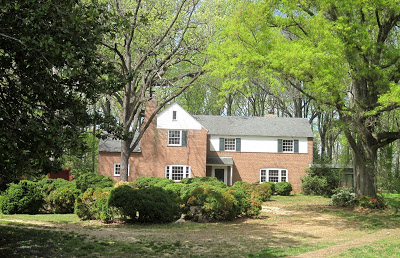Park Authority will seek a resident curator to care for the White Gardens
 |
| The house on the White Gardens property. |
Want to live free in a historic property in exchange for doing
some rehabilitation and maintenance work? Fairfax County’s resident curator program could be for you.
some rehabilitation and maintenance work? Fairfax County’s resident curator program could be for you.
The program, authorized by the Board of Supervisors in 2014,
is aimed at ensuring little-used, publicly owned historic properties are preserved for future generations.
is aimed at ensuring little-used, publicly owned historic properties are preserved for future generations.
There are more than 30 properties in Fairfax County eligible
for the resident curator program. The only one in Mason District is the John C. and Margaret K. White Gardens House and Barn. But the county is not actively
looking for a resident curator for that property yet, as several other historic
sites have a higher priority at this point, says Cindy Walsh, director of the
Resource Management Division at the Park Authority.
The first resident curator was recently selected for the
Stempson House, which was built in 1937 by prisoners in the Lorton Reformatory
as a residence for a prison officer. The Park Authority is having a lease
signing ceremony with the curator Dec. 5.
Stempson House, which was built in 1937 by prisoners in the Lorton Reformatory
as a residence for a prison officer. The Park Authority is having a lease
signing ceremony with the curator Dec. 5.
The next two properties for which the Park Authority is
actively seeking resident curators are the Turner Farmhouse in Great Falls and
the Ellmore Farmhouse in Frying Pan Farm Park in Herndon.
actively seeking resident curators are the Turner Farmhouse in Great Falls and
the Ellmore Farmhouse in Frying Pan Farm Park in Herndon.
 |
| The barn at the White Gardens needs extensive work. |
The White Gardens, a 13.6-acre park in the midst of a
residential area between Sleepy Hollow Road and Annandale Road, includes a
house built in the 1940s and a barn dating from around 1876. The resident curator would
live in the house and would be responsible for fixing up the house and barn,
both of which need extensive work, although the barn would be the top priority,
Walsh said.
residential area between Sleepy Hollow Road and Annandale Road, includes a
house built in the 1940s and a barn dating from around 1876. The resident curator would
live in the house and would be responsible for fixing up the house and barn,
both of which need extensive work, although the barn would be the top priority,
Walsh said.
John and Margaret White, the most recent owners of the property
cultivated an extensive collection of azaleas and rhododendrons. They ceded the property to the Park Authority following the death Margaret in 2010.
cultivated an extensive collection of azaleas and rhododendrons. They ceded the property to the Park Authority following the death Margaret in 2010.
To be considered for the resident curator program, a
property must be more than 50 years old, must be publicly owned, and must be
listed on the Fairfax County Inventory of Historic Sites.
property must be more than 50 years old, must be publicly owned, and must be
listed on the Fairfax County Inventory of Historic Sites.
The White property isn’t listed as a historic site yet. The county’s History Commission would decide if the property should be designated a historic
resource.
resource.
An individual or organization interested in being a resident
curator can submit a proposal to the Park Authority.
curator can submit a proposal to the Park Authority.
The curator would not pay any rent during the base lease
term as long as the curator continues to fulfill the obligations under the
lease. The curator could use sweat equity to fix up the property or hire contractors.
term as long as the curator continues to fulfill the obligations under the
lease. The curator could use sweat equity to fix up the property or hire contractors.
The curator would, however, pay all utilities; pay county real
estate taxes; pay for building permits; mow the grass and maintain the grounds; and would be
responsible for repairing and maintaining all appliances, HVAC, plumbing, and electrical
systems.
estate taxes; pay for building permits; mow the grass and maintain the grounds; and would be
responsible for repairing and maintaining all appliances, HVAC, plumbing, and electrical
systems.
Curators
could make certain improvements – like modernizing a kitchen or bathroom – that don’t
affect the “bones of the house,” Walsh said, but all work would be monitored by
a conservation manager.
The curator would also be required to:
- Submit and follow a work plan for historic rehabilitation that meets the Interior Department’s Standards for the Treatment
of Historic Properties. - Maintain records and photo documentation throughout the
rehabilitation process. - Prepare a historic certification application to qualify for historic
tax credits for properties not already listed on state or
federal historic registers. - Submit annual accounts of all expenses associated with the
rehabilitation and ongoing maintenance of the property. - Continually occupy the structure once rehabilitation is
complete. - Provide reasonable public access.

